

VxRail Interactive Journey – new whiteboard video on SaaS multi-cluster management
Fri, 30 Jul 2021 13:26:38 -0000
|Read Time: 0 minutes
As promised, we’re constantly refreshing content on the VxRail Interactive Journey. For those not familiar with the awesomeness of the VxRail Interactive Journey, you can check out this short blog. In the latest release, there is a brand-new whiteboard video to walk you through the architectural framework of SaaS multi-cluster management in VxRail HCI System Software. As customers look to scale their VxRail footprint, the need for simple global management grows.
In this whiteboard video, you will learn how we’re able to extend the operational simplicity in VxRail to SaaS multi-cluster management and deliver that experience to you on an easy-to-use web portal. The video covers three key areas of SaaS multi-cluster management.
- Monitoring – The Adaptive Data Collector service in VxRail HCI System Software gathers telemetry data from the HCI stack for more streamlined monitoring of all your clusters.
- Multi-cluster management – The added use of the Secure Remote Services gateway for bi-directional communication between the VxRail clusters and the web portal enables LCM services at scale.
- Security – The need for managing who has access to clusters becomes even more important with cluster configuration capabilities.
I invite you to check out this new whiteboard video in the VxRail Interactive Journey. You can find it in the SaaS multi-cluster management module.
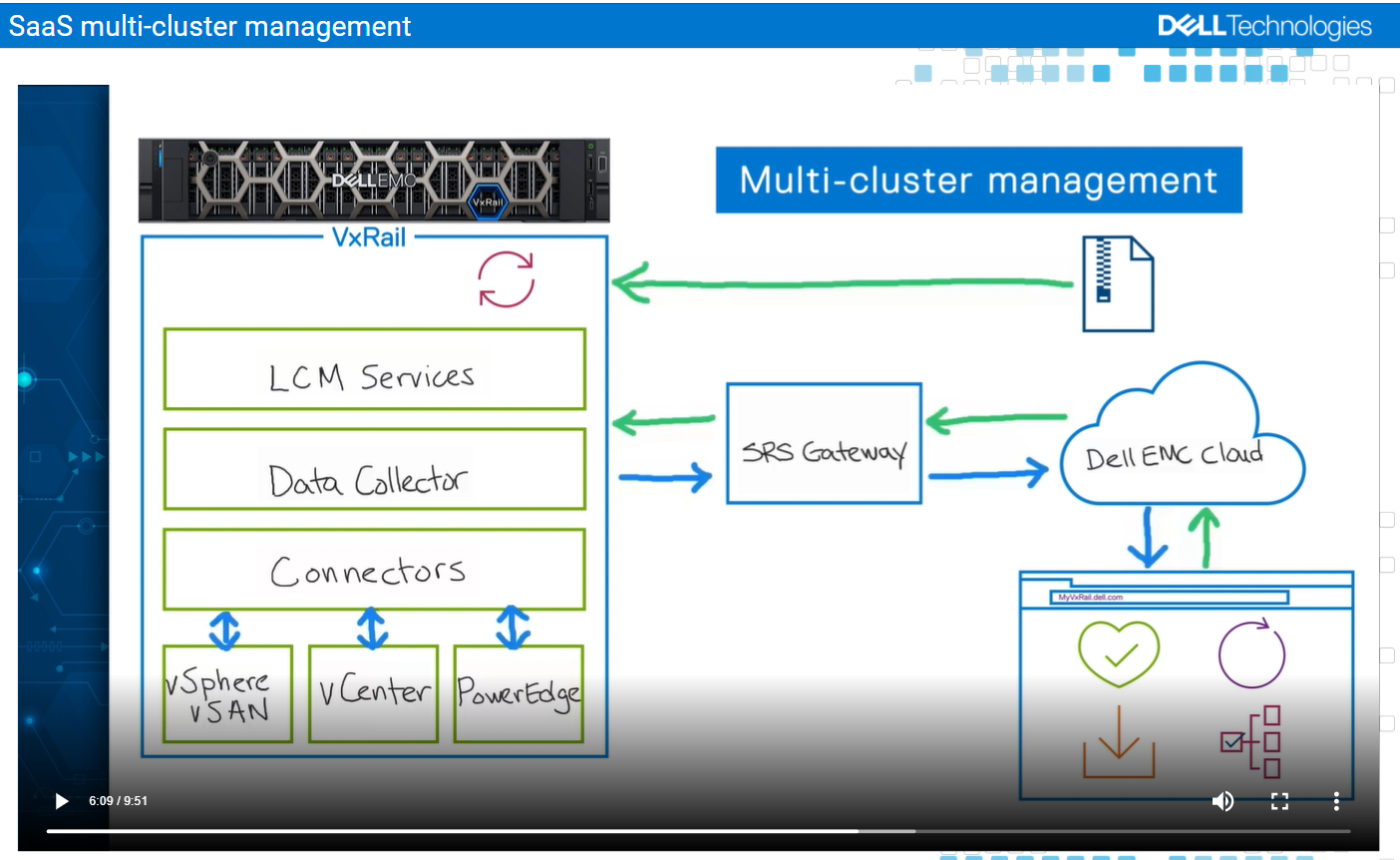

Related Blog Posts

Building on VxRail HCI System Software: the advantages of multi-cluster active management capabilities
Wed, 24 Apr 2024 11:57:53 -0000
|Read Time: 0 minutes
The signs of autumn are all around us, from the total takeover of pumpkin-spiced everything to the beautiful fall foliage worthy of Bob Ross’s inspiration. Like the amount of change autumn brings forth, so too does the latest release of VxRail ACE, or should I preface that with ‘formerly known as’? I’ll get to that explanation shortly.
This release introduces multi-cluster update functionality that will further streamline the lifecycle management (LCM) of your VxRail clusters at scale. With this active management feature comes a new licensing structure and role-based access control to enable the active management of your clusters.
Formerly known as VxRail ACE
The colors of the leaves are changing and so is the VxRail ACE name. The brand name VxRail ACE (Analytical Consulting Engine), will no longer be used as of this release. While it had a catchy name and was easy to say, there are two reasons for this change. First, Analytical Consulting Engine no longer describes the full value or how we intend to expand the features in the future. It has grown beyond the analytics and monitoring capabilities of what was originally introduced in VxRail ACE a year ago and now includes several valuable LCM operations that greatly expand its scope. Secondly, VxRail ACE has always been part of the VxRail HCI System Software offering. Describing the functionality as part of the overall value of VxRail HCI System Software, instead of having its own name, simplifies the message of VxRail’s value differentiation.
Going forward, the capability set (that is, analytics, monitoring, and LCM operations) will be referred to as SaaS multi-cluster management -- a more accurate description. The web portal is now referred to as MyVxRail.
Cluster updates
Cluster updates is the first active management feature offered by SaaS multi-cluster management. It builds on the existing LCM operational tools for planning cluster updates: on-demand pre-update health checks (LCM pre-check) and update bundle downloads and staging. Now you can initiate updates of your VxRail clusters at scale from MyVxRail. The benefits of cluster updates on MyVxRail tie closely with existing LCM operations. During the planning phase, you can run LCM pre-checks of the clusters you want to update. This informs you if a cluster is ready for an update and pinpoints areas for remediation for clusters that are not ready. From there, you can schedule your maintenance window to perform a cluster update and, from MyVxRail, initiate the download and staging of the VxRail update bundle onto those clusters. With this release, you can now execute cluster updates for those clusters. Now that’s operational efficiency!
When setting a cluster update operation, you have the benefit of two pieces of information – a time estimate for the update and the change data. The update time estimate will help you determine the length of the maintenance window. The estimate is generated by telemetry gathered about the install base to provide more accurate information. The change data is the list of the components that require an update to reach the target VxRail version.
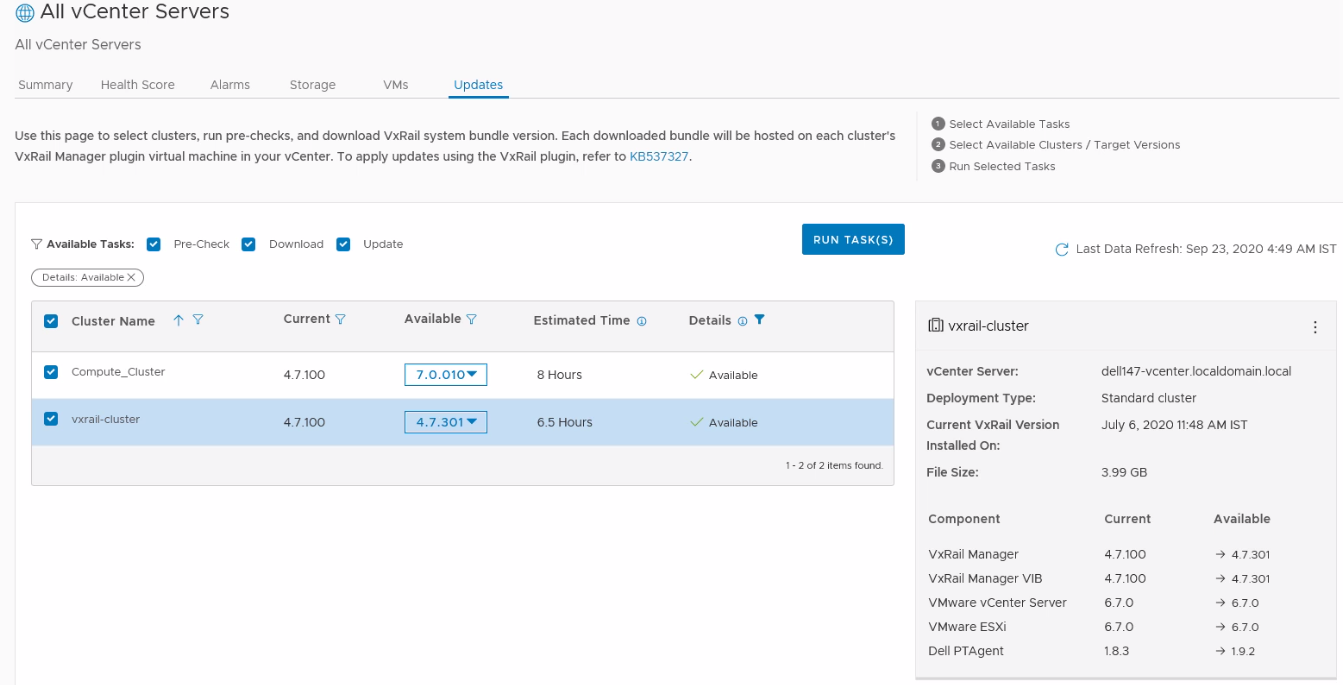
Figure 1 MyVxRail Updates tab
Role-based access control
Active management requires role-based access control so that you can provide permissions to the appropriate individuals to perform configuration changes to your VxRail clusters. You don’t want anyone with access to MyVxRail to perform cluster updates on the clusters. SaaS multi-cluster management leverages vCenter Access Control for role-based access. From MyVxRail, you will be able to register MyVxRail with the vCenter Servers that are managing your VxRail clusters. The registration process will give VxRail privileges to vCenter Server to build roles with specific SaaS multi-cluster management capabilities.
MyVxRail registers the following privileges on vCenter:
- Download software bundle: downloads and stages the VxRail software bundle onto the cluster
- Execute health check: performs an on-demand pre-update health check on the cluster
- Execute cluster update: initiates the cluster update operation on the clusters
- Manage update credentials: modifies the VxRail infrastructure credentials used for active management

Figure 2 VxRail privileges for vCenter access control
VxRail Infrastructure Credentials
We’ve done more to make it easier to perform cluster updates at scale. Typically, when you’re performing a single cluster update, you have to enter the root account credentials for vCenter Server, Platform Services Controller, and VxRail Manager. That’s the same process when performing it from VxRail Manager. But that process can get tedious when you have multiple clusters to update.
VxRail Infrastructure Credentials can store those credentials so you can enter them once, at the initial setup of active management, and not have to do it again as you perform a multi-cluster update. MyVxRail can read the stored credentials that are saved on each individual cluster for security.
Big time saver! But how secure is it? More secure than hiding Halloween candy from children. For a user to perform cluster update, the administrator needs to add the ‘execute cluster update’ privilege to the role assigned to that user. Root credentials can only be managed by users assigned with a role that has the ‘manage update credentials’ privilege.
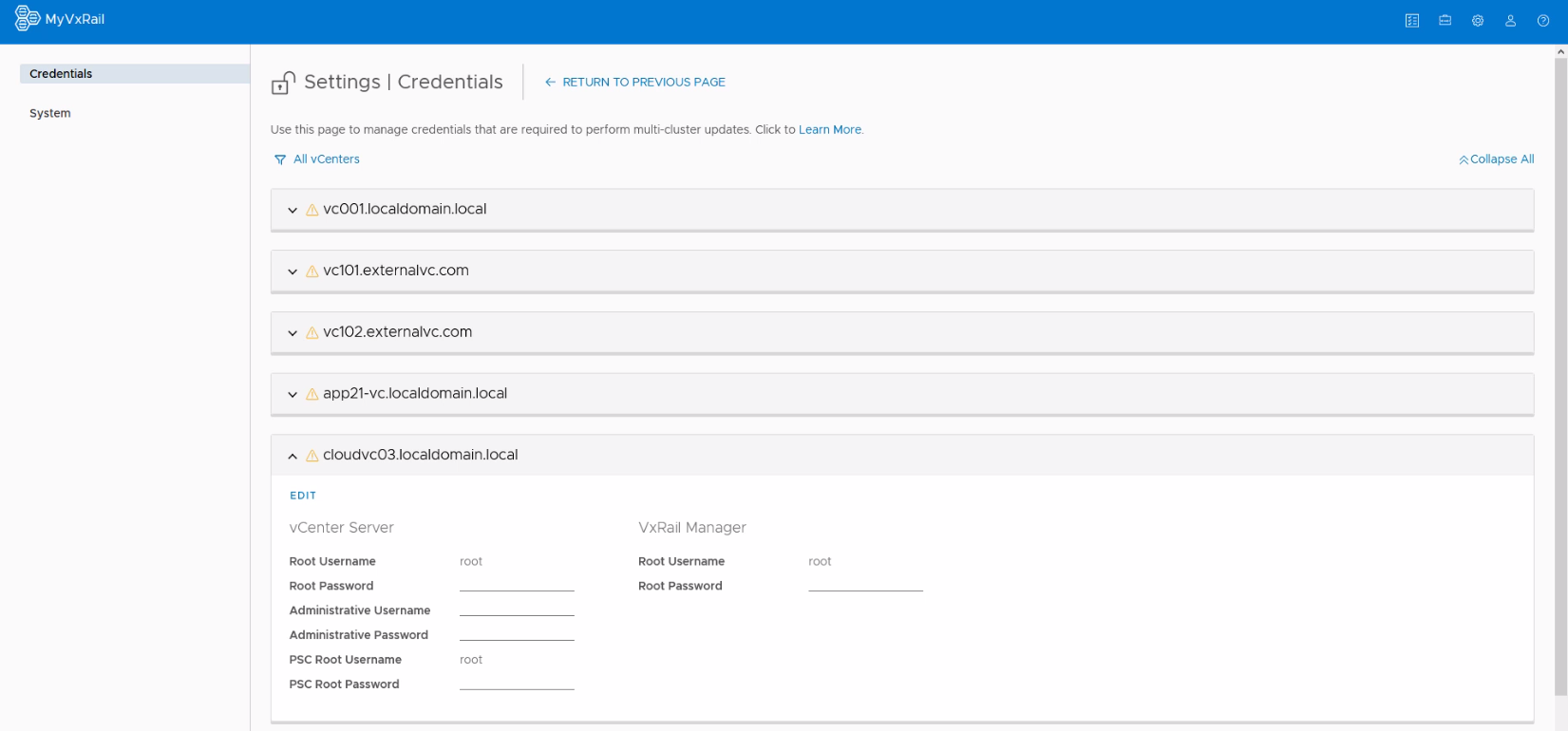
Figure 3 MyVxRail credentials manager
Licensing
The last topic is licensing. While all the capabilities you have been using on MyVxRail come with the purchase of the VxRail HCI System Software license, multi-cluster update is different. This feature requires a fee-based add-on software license called ‘SaaS active multi-cluster management for VxRail HCI System Software’. All VxRail nodes come with VxRail HCI System Software and you have access to MyVxRail and SaaS multi-cluster management features, except for cluster update. For you to perform an update of a cluster on MyVxRail, all nodes in the clusters must have the add-on software license.
Conclusion
That is a lot to consume for one release. Hopefully, unlike your Thanksgiving meal, you can stay awake for the ending. While the brand name VxRail ACE is no more, we’re continuing to deliver value-adding capabilities. Multi-cluster update is a great feature to further your use of MyVxRail for LCM of your VxRail clusters. With role-based access and VxRail infrastructure credentials, rest assured you’re benefitting from multi-cluster update without sacrificing security.
To learn more about these features, check out the VxRail techbook and the interactive demo for SaaS multi-cluster management.
Daniel Chiu, VxRail Technical Marketing

Learn More About the Latest Major VxRail Software Release: VxRail 7.0.480
Tue, 24 Oct 2023 15:51:48 -0000
|Read Time: 0 minutes
Happy Autumn, VxRail customers! As the morning air gets chillier and the sun rises later, this blog on our latest software release – VxRail 7.0.480 – paired with your Pumpkin Spice Latte will give you the boost you need to kick start your day. It may not be as tasty as freshly made cider donuts, but this software release has significant additions to the VxRail lifecycle management experience that can surely excite everyone.
VxRail 7.0.480 provides support for VMware ESXi 7.0 Update U3o and VMware vCenter 7.0 Update U3o. All existing platforms that support VxRail 7.0, except ones based on Dell PowerEdge 13th Generation platforms, can upgrade to VxRail 7.0.480. This includes the VxRail systems based on PowerEdge 16th Generation platforms that were released in August.
Read on for a deep dive into the VxRail Lifecycle Management (LCM) features and enhancements in this latest VxRail release. For a more comprehensive rundown of the features and enhancements in VxRail 7.0.480, see the release notes.
Improving update planning activities for unconnected clusters or clusters with limited connectivity
VxRail 7.0.450, released earlier this year, provided significant improvements to update planning activities in a major effort to streamline administrative work and increase cluster update success rates. Enhancements to the cluster pre-update health check and the introduction of the update advisor report were designed to drive even more simplicity to your update planning activities. By having VxRail Manager automatically run the update advisor report, inclusive of the pre-update health check, every 24 hours against the latest information, you will always have an up-to-date report to determine your cluster’s readiness to upgrade to the latest VxRail software version.
If you are not familiar with the LCM capabilities added in VxRail 7.0.450, you can review this blog for more information.
VxRail 7.0.450 offered a seamless path for clusters that are connected to the Dell cloud to take advantage of these new capabilities. Internet-connected clusters can automatically download LCM pre-checks and the installer metadata files, which provide the manifest information about the latest VxRail software version, from the Dell cloud. The ability to periodically scan the Dell cloud for the latest files ensures the update advisor report is always up to date to support your decision-making.
While unconnected clusters could use these features, the user experience in VxRail 7.0.450 made it more cumbersome for users to upload the latest LCM pre-checks and installer metadata files. VxRail 7.0.480 aims to improve the user experience for those who have clusters deployed in dark or remote sites that have limited network connectivity.
Starting in VxRail 7.0.480, users of unconnected clusters will have an easier experience uploading the latest LCM pre-checks file onto VxRail Manager. The VxRail Manager UI has been enhanced, so you no longer have to upload via CLI.
Knowing that some clusters are deployed in areas where network bandwidth is at a premium, the VxRail Manager UI has also been updated so that you only need to upload the installer metadata file to generate the update advisor report. In VxRail 7.0.450, users had to upload the full LCM bundle for the update advisor report. The difference in the payload size of greater than 10GB for a full LCM bundle versus a 50KB installer metadata file is a tremendous improvement for bandwidth-constrained clusters, eliminating a barrier to relying on the update advisor report as a standard cluster management practice. With VxRail 7.0.480, whether you have connected or unconnected clusters, these update planning features are easy to use and will help increase your cluster update success rates.
To accommodate these improvements, the Local Updates tab has been modified to support these new capabilities. There are now two sub-tabs underneath the Local Updates tab:
- The Update sub-tab represents the existing cluster update workflow where you would upload the full LCM bundle to generate the update advisor report and initiate the cluster update operation.
- The Plan and Update sub-tab is the recommended path which incorporates the enhancements in VxRail 7.0.480. Here you can upload the latest LCM pre-checks file and the installer metadata file that you found and downloaded from the Dell Support website. Uploading the LCM pre-checks file is optional to create a new report because there may not always be an updated file to apply. However, you do need to upload an installer metadata file to generate a new report from here. Once uploaded, VxRail Manager will generate an update advisor report against that installer metadata file every 24 hours.
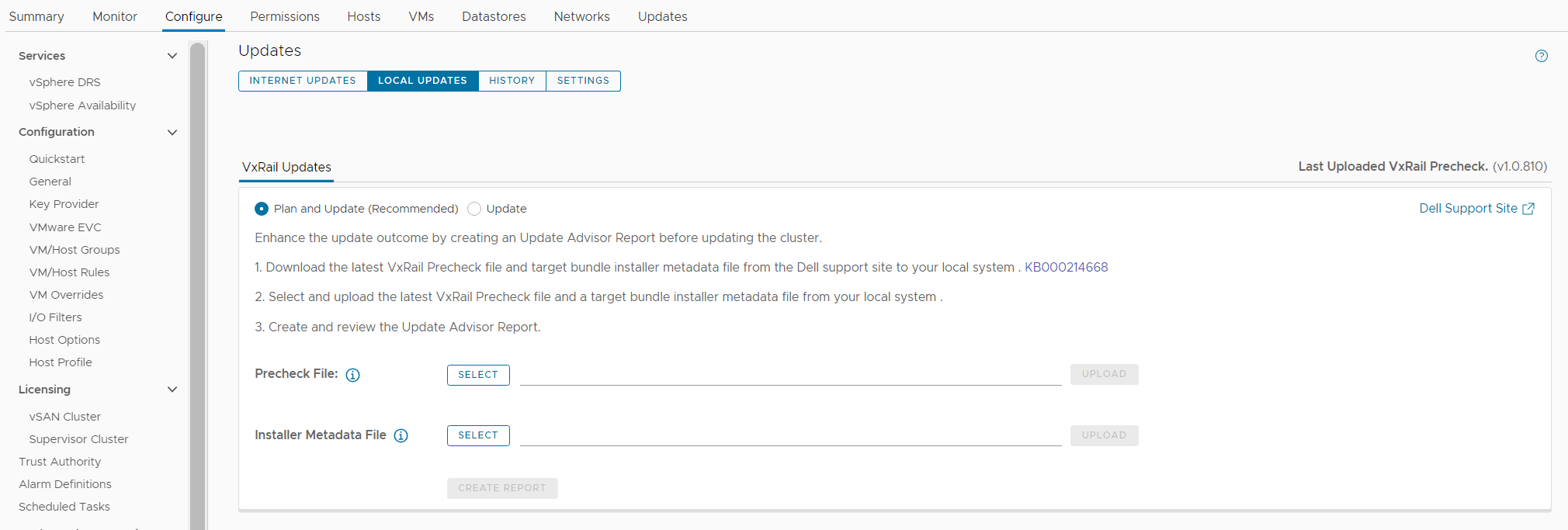
Figure 1. New look to the Local Updates tab
Easier record-keeping for compliance drift and update advisor reports
VxRail 7.0.480 adds new functionality to make the compliance drift reports exportable to outside the VxRail Manager UI while also introducing a history tab to access past update advisor reports.
Some of you use the contents of the compliance drift report to build out a larger infrastructure status report for information sharing across your organizations. Making the report exportable would simplify that report building process. When exporting the report, there is an option to group the information by host if you prefer.
Note that the compliance check functionality has moved from the Compliance tab under the Updates page to a separate page, which you can navigate to by selecting Compliance from under the VxRail section.
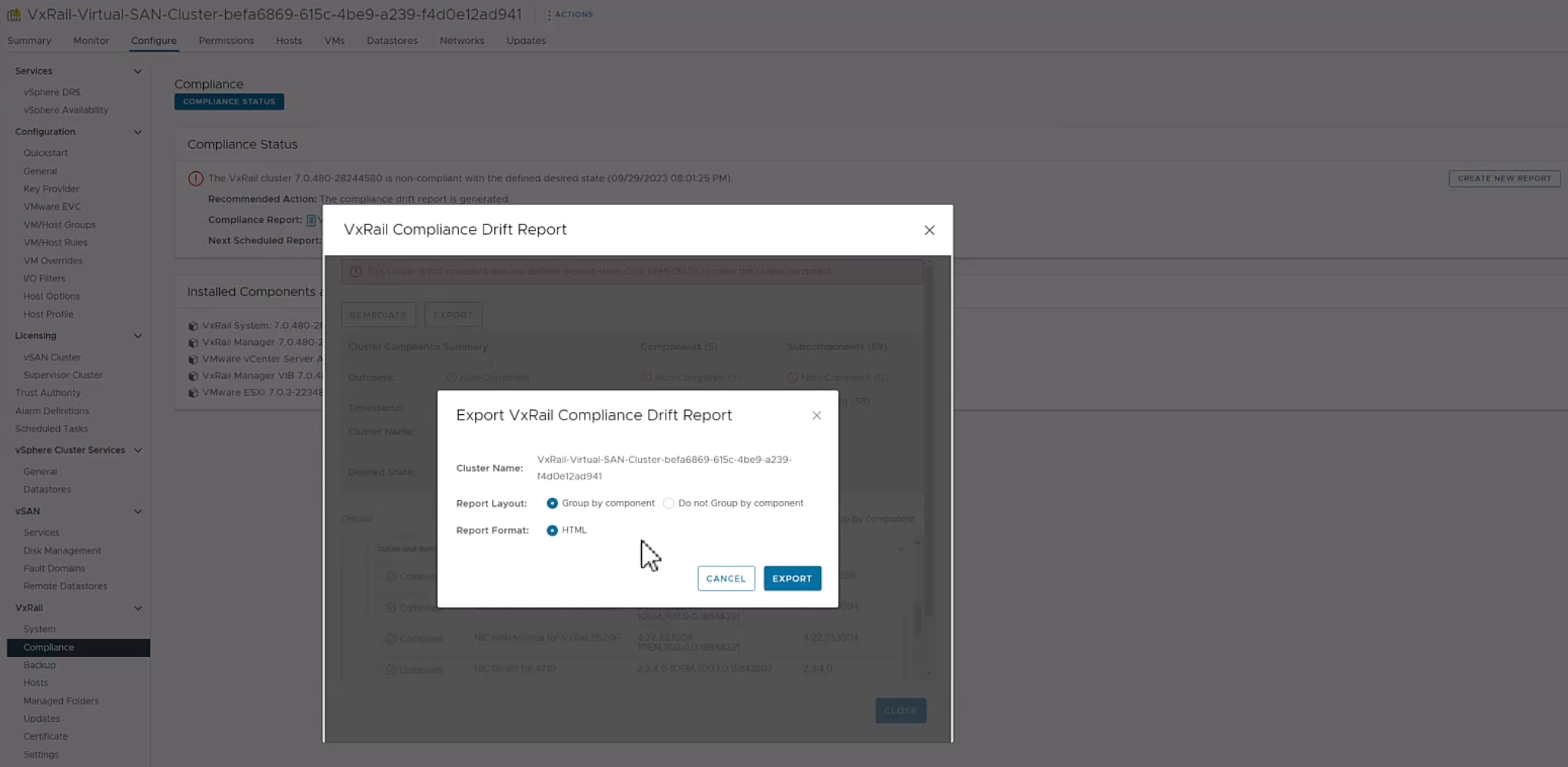
Figure 2. Exporting the compliance drift report
The exit of the Compliance tab comes with the introduction of the History tab on the Updates page in VxRail 7.0.480. Because VxRail Manager automatically generates a new update advisor report every 24 hours and you have the option to generate one on-demand, the update advisor report is often overwritten. To avoid the need to constantly export them as a form of record-keeping, the new History tab stores the last 30 update advisor reports. The reports are listed in a table format where you can see which target version the report was run against and when it was run. To view the full report, you can click on the icon on the left-hand column.
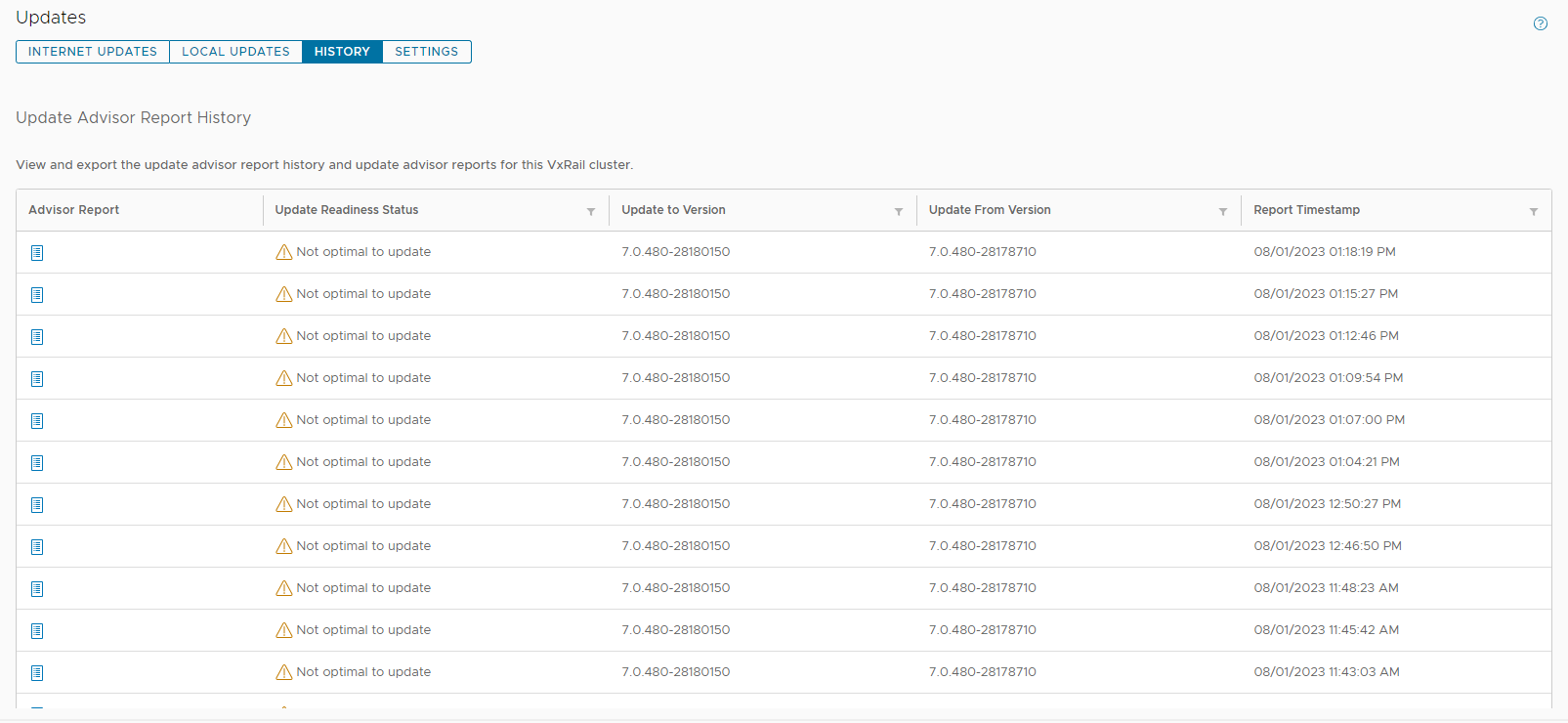
Figure 3. New History tab to store the last 30 update advisor reports
Addressing cluster update challenges for larger-sized clusters
For some of you that have larger-sized clusters, cluster updates pose challenges that may prevent you from upgrading more frequently. For example, the length of the maintenance window required to complete a full cluster update may not fit within your normal business operations such that any cluster update activity will impact service availability. As a result, cluster updates are kept to a minimum and nodes inevitably are not rebooted for long periods of time. While the cluster pre-update health check is an effective tool to determine cluster readiness for an upgrade, some issues may be lurking that a node reboot can uncover. That’s why some of you script your own node reboot sequence that acts as a test run for a cluster upgrade. The script reboots each node one at a time to ensure service levels of your workloads are maintained. If any nodes fail to reboot, you can investigate those nodes.
VxRail 7.0.480 introduces the node reboot sequence on VxRail Manager UI so that you do not have to manage your scripts anymore. The new feature includes cluster-level and node-level prechecks to ensure it is safe to perform this activity. If nodes fail to reboot, there is an option for you to retry the reboot or skip it. Making this activity easy may also encourage more customers to do this additional pre-check before upgrading their clusters.

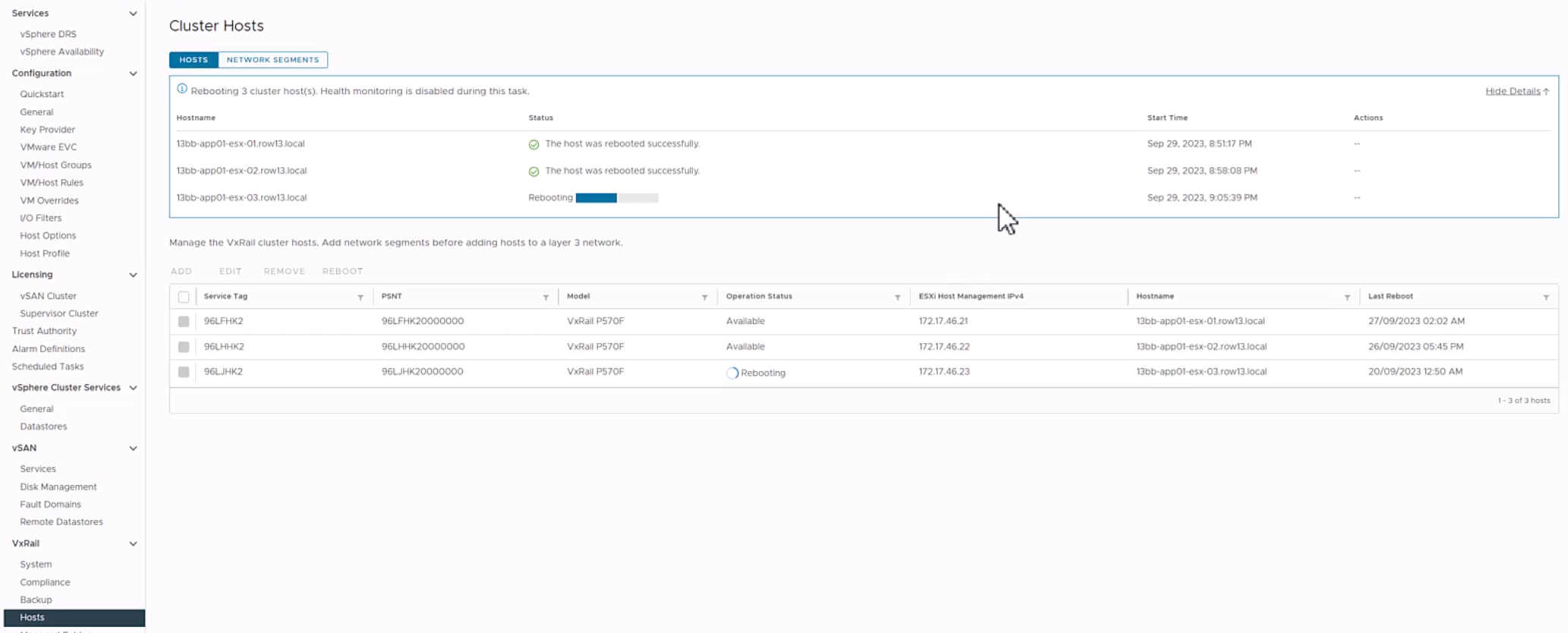
Figure 5. Monitoring the node reboot sequence on the dashboard
VxRail 7.0.480 also provides the capability to split your cluster update into multiple parts. Doing so allows you to separate your cluster upgrade into smaller maintenance windows and work around your business operation needs. Though this capability could reduce the impact of a cluster upgrade to your organization, VMware does recommend that you complete the full upgrade within one week given that there are some Day 2 operations that are disabled while the cluster is partially upgraded. VxRail enables this capability only through VxRail API. When a cluster is in a partially upgraded state, features in the Updates tab are disabled and a banner appears alerting you of the cluster state. Cluster expansion and node removal operations are also unavailable in this scenario.
Conclusion
The new lifecycle management capabilities added to VxRail 7.0.480 are part of the continual evolution of the VxRail LCM experience. They also represent how we value your feedback on how to improve the product and our dedication to making your suggestions come to fruition. The LCM capabilities added to this software release will drive more effective cluster update planning, which will result in higher rates of cluster update success that will drive more efficiencies in your IT operations. Though this blog focuses on the improvements in lifecycle management, please refer to the release notes for VxRail 7.0.480 for a complete list of features and enhancements added to this release. For more information about VxRail in general, visit the Dell Technologies website.
Author: Daniel Chiu


